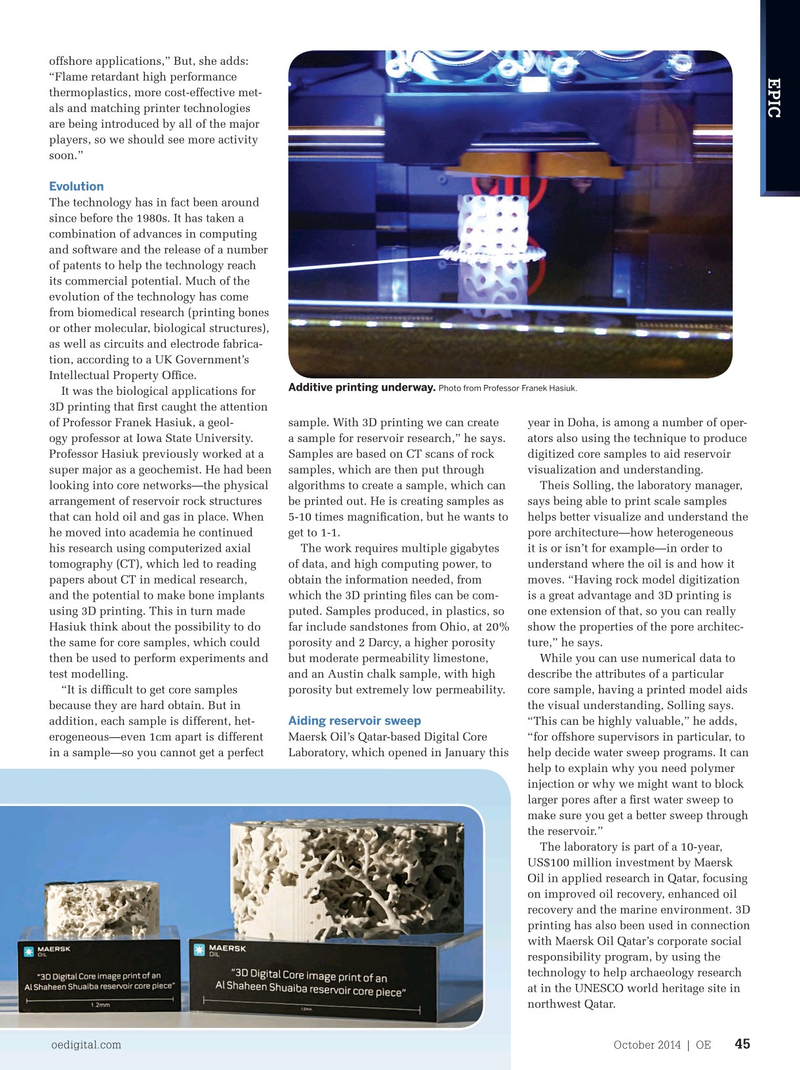
Page 43: of Offshore Engineer Magazine (Oct/Nov 2014)
Read this page in Pdf, Flash or Html5 edition of Oct/Nov 2014 Offshore Engineer Magazine
offshore applications,” But, she adds:
EPIC “Flame retardant high performance thermoplastics, more cost-effective met- als and matching printer technologies are being introduced by all of the major players, so we should see more activity soon.”
Evolution
The technology has in fact been around since before the 1980s. It has taken a combination of advances in computing and software and the release of a number of patents to help the technology reach its commercial potential. Much of the evolution of the technology has come from biomedical research (printing bones or other molecular, biological structures), as well as circuits and electrode fabrica- tion, according to a UK Government’s
Intellectual Property Of? ce.
Additive printing underway. Photo from Professor Franek Hasiuk.
It was the biological applications for 3D printing that ? rst caught the attention of Professor Franek Hasiuk, a geol- sample. With 3D printing we can create year in Doha, is among a number of oper- ogy professor at Iowa State University. a sample for reservoir research,” he says. ators also using the technique to produce
Professor Hasiuk previously worked at a Samples are based on CT scans of rock digitized core samples to aid reservoir super major as a geochemist. He had been samples, which are then put through visualization and understanding. looking into core networks—the physical algorithms to create a sample, which can Theis Solling, the laboratory manager, arrangement of reservoir rock structures be printed out. He is creating samples as says being able to print scale samples that can hold oil and gas in place. When 5-10 times magni? cation, but he wants to helps better visualize and understand the he moved into academia he continued get to 1-1. pore architecture—how heterogeneous his research using computerized axial The work requires multiple gigabytes it is or isn’t for example—in order to tomography (CT), which led to reading of data, and high computing power, to understand where the oil is and how it papers about CT in medical research, obtain the information needed, from moves. “Having rock model digitization mechanical milling, spray forming, and and the potential to make bone implants which the 3D printing ? les can be com- is a great advantage and 3D printing is other methods, and a direct metal laser using 3D printing. This in turn made puted. Samples produced, in plastics, so one extension of that, so you can really melting machine. Hasiuk think about the possibility to do far include sandstones from Ohio, at 20% show the properties of the pore architec-
According to Monica Schnitger, from the same for core samples, which could porosity and 2 Darcy, a higher porosity ture,” he says.
market intelligence ? rm Schnitger Corp., then be used to perform experiments and but moderate permeability limestone, While you can use numerical data to there is not much additive manufacturing test modelling. and an Austin chalk sample, with high describe the attributes of a particular in the offshore sector yet. “It is dif? cult to get core samples porosity but extremely low permeability. core sample, having a printed model aids “Most 3D printing today is still because they are hard obtain. But in the visual understanding, Solling says.
Aiding reservoir sweep making plastic parts, which addition, each sample is different, het- “This can be highly valuable,” he adds, don’t meet temperature erogeneous—even 1cm apart is different Maersk Oil’s Qatar-based Digital Core “for offshore supervisors in particular, to or pressure specs for in a sample—so you cannot get a perfect Laboratory, which opened in January this help decide water sweep programs. It can help to explain why you need polymer injection or why we might want to block larger pores after a ? rst water sweep to make sure you get a better sweep through the reservoir.”
The laboratory is part of a 10-year,
US$100 million investment by Maersk
Oil in applied research in Qatar, focusing on improved oil recovery, enhanced oil recovery and the marine environment. 3D printing has also been used in connection with Maersk Oil Qatar’s corporate social responsibility program, by using the technology to help archaeology research at in the UNESCO world heritage site in northwest Qatar.
oedigital.com October 2014 | OE 45 044_OE1014_EPIC1_3D.indd 45 9/23/14 1:46 PM

 42
42

 44
44